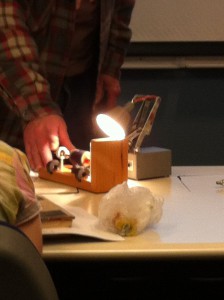During last week’s class, the students were divided into teams to determine the groups for the course’s final project. I chose to join Phil Sommer’s group, as I have worked with him throughout the semester, and was similarly followed by our usual third member, Angela Bray.
Going into the first team meeting, none of us had any solidified ideas for our final project; interested to see what we could find on the Internet, we skimmed through the provided websites on the project description and also searched for our own. We came across one PDF file from the North Carolina Solar Center and, upon review of the document, decidedly found our experiment for the final project.

A solar cooker, or solar oven, requires few supplies for its building process, yet yields surprisingly efficient cooking results once solar energy is added to its construction. For the option we found from the North Carolina Solar Center, the experiment requires eight common materials: a cardboard box, foam for insulation, aluminum foil, plastic food wrap, sticks, tape, black paint, and string. Upon finishing its quick construction, the solar cooker will appear as demonstrated in Fig. 1. Concerned with the hour-long time for cooking alone, we sought a faster option for our experiment. What we found was an article written by Don Shepard for a fast-heating solar oven.
For this solar oven experiment, there are fewer necessary supplies, assumedly resulting in a simpler construction design. Shepard’s experiment calls for a pizza box, black paint, aluminum foil, plastic wrap, string, and a thumbtack. Notice the lack of foam insulation for heat entrapment. Shepard writes that for maximum heating speed for this experiment, the top of the pizza box (known as the flap in this case) can be adjusted to allow more solar energy to collect in the apparatus.
Our final decision for our team project is to compare and contrast the efficiency of the two solar oven options; while the first one requires a bit more time, it has a broader range of food options than Shepard’s experiment, who warns that heavier food items should not be used in his version of the solar cooker. However, Shepard’s experiment offers a faster cooking time than the hour-long procedure of the first, and requires fewer supplies and construction time. Our plan, as of now, is to experiment with Option A (North Carolina Solar Center) and Option B (Don Shepard) using pre-cooked bacon, and test the two versions in a given time period for how well they heat the bacon with the energy from the Sun. It should be noted that this was only our first team meeting, and specific details of our final project will be worked out in future meetings.
Sources:
North Carolina Solar Center. “Solar Activities for Students.” Solar Center Information. Sept. 2001. Web. 19 Mar. 2012.
Shepard, Don. “How to Make a Fast Heating Solar Oven.” eHow Food. 2009. Web. 19 Mar. 2012.





